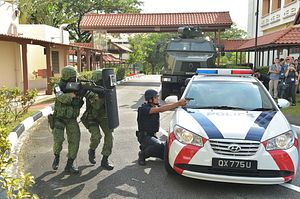In an Islamic State video released in September 2017, Singaporean jihadi Megat Shahdan who goes by the nom de guerre of Abu Uqayl, threatened to launch attacks in Singapore. He also called on Singaporeans and other Muslims to support the Islamic State and its objectives.
On December 30, 2017, pro-ISIS Khayr Wilayah media house released a new 8 minute video titled “Abandon the State,” with Abu Uqayl as its star. While past ISIS videos tended to have Indonesians and Malaysians as spokespeople, in this video, the English-speaking Abu Uqayl was the anchor man. Along the lines of the late Abu Muhammad al-Adnani, the official spokesperson of ISIS, killed in August 2016, the video called on Islamic State’s supporters to go on the offensive. Abu Uqayl talked of the need to “slay the enemies of Allah wherever one can find them.”
The video was presented in both Arabic and English; in addition to Abu Uqayl, there were two other Southeast Asians in the video, probably Malaysians. Abu Uqayl called on Muslims to undertake hidjrah or strategic migration to al-Sham, namely, the Islamic State of Syria and Iraq, or to any of its wilayahs or provinces. Abu Uqayl described the Islamic State as spanning from East Asia to West Africa.
The climax of the video was the execution of three prisoners, who appeared to be Arabs. They were murdered by Abu Uqayl and the other two Southeast Asians.
At a time when the mainstream media is talking about the demise of the Islamic State, the video was a reminder that the group is still alive and kicking. While ISIS may have lost most of its territory in Syria and Iraq, their operatives are still around and hence, continue to be a threat.
As this video was mainly targeted to the Southeast Asian region, it aimed to signal that even though the five-month siege of Marawi city in the southern Philippines may have ended with its key ISIS leaders killed, Southeast Asian jihadists are still around to continue their mission of establishing an Islamic Caliphate. In short, this was a post-Marawi message to demonstrate that the threat of the jihadists remains as relevant today as it was in the past.
The video was also meant to signal that there remain many Southeast Asian jihadists, be it in the Middle East, as shown in the video, or elsewhere, as there was the call to support their cause in other ISIS wilayats.
There was also a specific Singapore-targeted message. With the Singapore authorities talking of the ISIS threat being “not if but when,” Abu Uqayl’s presence in the video was meant to signal that Singapore remains a key target of the Islamic State.
Despite some euphoria in certain capitals that ISIS has been defeated, the video sent a clear message that the Islamic State’s threat, especially in Southeast Asia, is real and imminent. The use of brute violence to achieve the political objectives of an Islamic Caliphate remains as relevant today as in the past.
Despite the presence of hundreds of Southeast Asian fighters in ISIS, with a dedicated military unit called Katibah Nusantara as part of its fighting force, no major attack has taken place in the region other than the Marawi Siege, which cost more than 1,000 lives. The video signals that ISIS may be training its guns in the region as it prepares to disperse its fighters from the Middle East back to their homes of origins.
While many Southeast Asian jihadists supporting the Islamic State are known, more are unknown and this is where the real threat exists. How do states counter terrorists who are “unknown unknowns”? Just as Abu Uqayl emerged suddenly in September 2017, the identity of the two presumed Malaysians remains unclear, even though they are believed to be Muhammad Afiq Heusen and Muhammad Aqif Huesen, or their associates. The key question is how many other unknown Southeast Asian jihadists exist in the Middle East who have chalked up immense combat experience, been involved in executions, developed networks with other jihadists, and are steeped in radical ideology?
Most important of all, the emergence of Singapore as an ISIS target is now clear. For Singapore, Abu Uqayl is the most dangerous terrorist bar none that has emerged in the last few decades. While there are many others, such as Mas Selamat, only Abu Uqayl is a known murderer, combat experienced, and dedicated to achieving his goals through violence. He symbolizes the most dangerous terrorist threat to Singapore today, be it through his inspiration, his messages in his two videos so far, or — worse still — if he ever slips back into Singapore.
For Singapore in particular and Southeast Asia in general, the December 30 ISIS video reinforces the need to be vigilant as the Islamic State remains an existential threat. The video is a daring challenge to states and it is up to Southeast Asian governments to respond to ensure that the terrorists do not succeed even once.
Bilveer Singh is an Associate Professor at the Department of Political Science, National University of Singapore; and an Adjunct Senior Fellow, Centre of Excellence for National Security, S. Rajaratnam School of International Studies, Nanyang Technological University, Singapore.

































